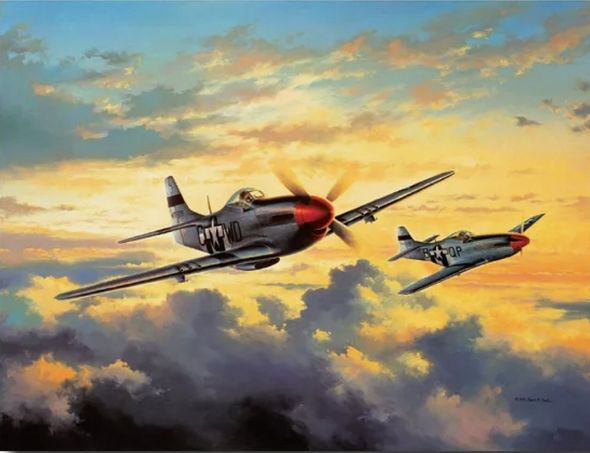
David Poole Pilot Co-Signed Limited Edition Print: "Combat Leaders"
"Combat Leaders" Fourth Fighter Group P-51 Mustang - Limited Edition Print
Edition Size: Limited Edition of 1100
Signed By: The Artist and One Pilot
Image Size: 25" x 19"
Paper Size: 31" x 25.5"
Plane Type: P-51 Mustang
Description: The Fourth Fighter Group, led by Col. Don Blakeslee, was one of the most successful P-51 groups of World War II. With their first pilots coming from the three RAF American volunteer Eagle Squadrons, the 4th FG was credited with destroying more than 1000 German aircraft. This print depicts Col. Blakeslee flying with fellow 4th FG pilot, Col. James Clarke. The print is personally autographed by Col. Don Blakeslee.
About Col. Don Blakeslee and the 4th Fighter Group
Col. Donald J.M. Blakeslee was a renowned fighter pilot and one of the finest American combat leaders of World War II. He joined the Royal Canadian Air Force and later transferred to the USAAF, where he commanded the 4th Fighter Group.
Under Blakeslee's leadership, the 4th Fighter Group became the top-scoring Allied Fighter Group of the war, destroying over 1000 enemy aircraft. The group was equipped with P-51 Mustangs, which they flew until the end of the war in Europe.
The P-51 Mustang was a game-changer in air combat, providing long-range escort for bombers and proving superior to many German fighters. Blakeslee's aggressive leadership style and combat experience were crucial in forging the 4th Fighter Group into one of the most formidable and successful USAAF fighter units.
This limited edition print captures a moment in the illustrious history of the 4th Fighter Group and pays tribute to the skill and bravery of pilots like Col. Blakeslee, who played a pivotal role in achieving air superiority during World War II.










